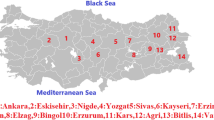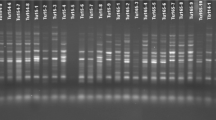Abstract
Background
Scarlet eggplant (Solanum aethiopicum gr. gilo) is a part of African indigenous vegetables and acknowledged as a source of variations in the breeding of Brinjal. Since its genetic diversity is still largely unexplored, therefore genetic diversity and population structure of this plant were investigated in this study.
Methods and results
Scarlet eggplant germplasm made of fifty-two accessions originated from two districts of Rwanda was assessed by employing the iPBS-retrotransposon markers system. Twelve most polymorphic primers were employed for molecular characterization and they yielded 329 total bands whereupon 85.03% were polymorphic. The recorded mean polymorphism information content was 0.363 and other diversity indices such as; mean the effective number of alleles, mean Shannon’s information index and gene diversity with the following values; 1.298, 0.300 and 0.187 respectively. A superior level of diversity was noticed among accessions from Musanze district. The model-based structure, neighbor-joining, and principal coordinate analysis (PCoA) gathered scarlet germplasm in a divergence manner to their collection district. Analysis of molecular variance (AMOVA) displayed that the utmost variations (81%) in scarlet eggplant germplasm are resulting in differences within populations.
Conclusions
The extensive diversity of scarlet eggplant in Rwanda might be used to form the base and genetic resource of an exhaustive breeding program of this economically important African indigenous vegetable. For instance, accessions MZE53 and GKE11 might be proposed as parent candidates due to their high relative genetic distance (0.6781).




Similar content being viewed by others
Data availability
The datasets used for the current study are available from the corresponding author on reasonable request.
References
Caguiat XGI, Hautea DM (2014) Genetic diversity analysis of eggplant (Solanum melongena L.) and related wild species in the Philippines using morphological and SSR markers. SABRAO J Breed Genet 46(2):183–201
Isshiki S, Iwata N, Khan MMR (2008) ISSR variations in eggplant (Solanum melongena L.) and related Solanum species. Sci Hortic 117:186–190. https://doi.org/10.1016/j.scienta.2008.04.003
Kamga RT, Kouamé C, Atangana AR, Abdulai MS, Tenkouano A (2015) Characterization of African eggplant accessions for morphological and yield parameters in the bimodal rainfall agroecology of Cameroon. Acta Hortic 1102:109–120. https://doi.org/10.17660/ActaHortic.2015.1102.13
Song B, Song Y, Fu Y, Kizito EB, Kamenya SN et al (2019) Draft genome sequence of Solanum aethiopicum provides insights into disease resistance, drought tolerance, and the evolution of the genome. GigaScience 8:1–16. https://doi.org/10.1093/gigascience/giz115
Weller SC, Van Wyk E, Simon JE (2015) Sustainable production for more resilient food production systems: Case study of African indigenous vegetables in eastern Africa. Acta Hortic 1102:289–297. https://doi.org/10.17660/ActaHortic.2015.1102.35
Doganlar S, Frary A, Daunay MC, Lester RN, Tanksley SD (2002) A comparative genetic linkage map of eggplant (Solanum melongena) and its implications for genome evolution in the Solanaceae. Genetics 161(4):1697–1711. https://doi.org/10.1093/genetics/161.4.1697
Knapp S, Aubriot X, Prohens J (2019) Eggplant (Solanum melongena L.): Taxonomy and relationships. In: Chapman MA (ed) The eggplant genome. Springer, Cham, pp 11–22
Knapp S, Vorontsova MS, Prohens J (2013) Wild relatives of the eggplant (Solanum melongena L.: Solanaceae): New understanding of species names in a complex group. PLoS ONE 8(2):1–12. https://doi.org/10.1371/journal.pone.0057039
Haliński ŁP, Samuels J, Stepnowski P (2017) Multivariate analysis as a key tool in chemotaxonomy of brinjal eggplant, African eggplants and wild related species. Phytochemistry 144:87–97. https://doi.org/10.1016/j.phytochem.2017.09.001
Lester RN, Daunay MC (2003) Diversity of African vegetable Solanum species and its implications for a better understanding of plant domestication. In: Knüpffer H, Ochsmann (eds) Proceedings of a symposium dedicated to the 100th birthday of Rudolf Mansfeld, ZADI, Bonn, pp 136–152
Mibei EK, Owino WO, Ambuko J, Giovannoni JJ, Onyango AN (2018) Metabolomic analyses to evaluate the effect of drought stress on selected African eggplant accessions. J Sci Food Agric 98(1):205–216. https://doi.org/10.1002/jsfa.8458
Sseremba G (2019) Genetic diversity and breeding of Solanum aethiopicum shum group for drought tolerance. PhDThesis. University of Ghana, Accra
Gramazio P, Blanca J, Ziarsolo P, Herraiz FJ, Plazas M et al (2016) Transcriptome analysis and molecular marker discovery in Solanum incanum and S. aethiopicum, two close relatives of the brinjal eggplant (Solanum melongena) with interest for breeding. BMC Genom 17(1):300. https://doi.org/10.1186/s12864-016-2631-4
Kansiime MK, Karanja DK, Alokit C, Ochieng J (2018) Derived demand for African indigenous vegetable seed: implications for farmer-seed entrepreneurship development. Int Food Agribus Manag Rev 21(6):723–739. https://doi.org/10.22434/ifamr2017.0095
Shah MA, Khan AI, Awan FS, Sadaqat HA, Bahadur S et al (2014) Genetic diversity of some tomato cultivars and breeding lines commonly used in Pakistani breeding program. Turk J Agric Food Sci 3(3):126–132. https://doi.org/10.24925/turjaf.v3i3.126-132.249
Adeniji OT, Kusolwa PM, Reuben SOWM (2012) Genetic diversity among accessions of Solanum aethiopicum L. groups based on morpho-agronomic traits. Plant Genet Resour 10(3):177–185. https://doi.org/10.1017/S1479262112000226
Larochelle C, Alwang JR (2014) Impacts of improved bean varieties on food security in rwanda impacts of improved bean varieties on food security in Rwanda. Agricultural and Applied Economics Association (AAEA) Conferences. https://ageconsearch.umn.edu/record/170567?ln=en. Accessed 19 Apr 2021
Prasad PVV, Hijmans R J, Pierzynski GM, Middendorf JB (2016) Climate Smart Agriculture and Sustainable Intensification: Assessment and Priority Setting for Rwanda. Feed the Future Sustainable Intensification Innovation Lab, Kansas State University, Manhattan
Van Dijk N, Elings A (2014) Horticulture in Rwanda: Possibilities for Further Development. BoP Innovation Center–28, Wageningen University, Wageningen
Schreinemachers P, Sequeros T, Lukumay PJ (2017) International research on vegetable improvement in East and Southern Africa: adoption, impact, and returns. Agric Econ 48:707–717. https://doi.org/10.1111/agec.12368
Dijkxhoorn Y, Saavedra Gonzalez Y, Judge LO (2016) Horticulture and floriculture in Rwanda Identification of focus areas for sector development. LEI Wageningen UR, Wageningen
Uwamahoro F, Yuen J, Berlin A, Bucagu C, Bylund H (2020) Ralstonia solanacearum causing potato bacterial wilt: host range and cultivars’ susceptibility in Rwanda. Plant Pathol 69(3):559–568. https://doi.org/10.1111/ppa.13140
Kalendar R, Antonius K, Smýkal P, Schulman HA (2010) iPBS: a universal method for DNA fingerprinting and retrotransposon isolation. Theor Appl Genet 121:1419–1430. https://doi.org/10.1007/s00122-010-1398-2
Ali F, Yılmaz A, Nadeem MA, Habyarimana E, Subaşı I et al (2019) Mobile genomic element diversity in world collection of safflower (Carthamus tinctorius L.) panel using iPBS-retrotransposon markers. PLoS ONE 14(2):1–19. https://doi.org/10.1371/journal.pone.0211985
Baloch FS, Alsaleh A, de Miera LES, Hatipoğlu R, Çifti V et al (2015) DNA based iPBS-retrotransposon markers for investigating the population structure of pea (Pisum sativum) germplasm from Turkey. Biochem Syst Ecol 61:244–252. https://doi.org/10.1016/j.bse.2015.06.017
Barut M, Nadeem MA, Karaköy T, Baloch FS (2020) DNA fingerprinting and genetic diversity analysis of world quinoa germplasm using iPBS-retrotransposon marker system. Turk J Agric For 44:479–491. https://doi.org/10.3906/tar-2001-10
Yaldız G, Camlica M, Nadeem MA, Nawaz MA, Baloch FS (2018) Genetic diversity assessment in Nicotiana tabacum L. with iPBS-retrotransposons. Turk J Agric For 42:154–164. https://doi.org/10.3906/tar-1708-32
Yıldız M, Koçak M, Baloch FS (2015) Genetic bottlenecks in Turkish okra germplasm and utility of iPBS retrotransposon markers for genetic diversity assessment. Genet Mol Res 14:10588–10602. https://doi.org/10.4238/2015.September.8.20
Yıldız M, Koçak M, Nadeem MA, Cavagnaro P, Barboza K et al (2019) Genetic diversity analysis in the Turkish pepper germplasm using iPBS retrotransposon-based markers. Turk J Agric For 44:1–14. https://doi.org/10.3906/tar-1902-10
Stedje B, Bukenya-Ziraba R (2003) RAPD variation in Solanum anguivi Lam. and S. aethiopicum L. (Solanaceae) in Uganda. Euphytica 131(3):293–297. https://doi.org/10.1023/A:1024079208879
Sunseri F, Polignano GB, Alba V, Lotti C, Bisignano V et al (2010) Genetic diversity and characterization of African eggplant germplasm collection. Afr J Plant Sci 4(7):231–241. https://doi.org/10.5897/AJPS.9000128
Tümbilen Y, Frary A, Daunay MC, Doğanlar S (2011) Application of EST-SSRs to examine genetic diversity in eggplant and its close relatives. Turk J Agric For 35:125–136. https://doi.org/10.3906/biy-0906-57
Doyle JJ, Doyle JL (1990) Isolation of plant DNA from fresh tissue. Focus 12:13–15
Yeh FC, Yang R, Boyle TJ, Ye Z, Xiyan JM (2000) PopGene32, Microsoft Windows-based freeware for population genetic analysis, version 1.32. Molecular Biology and Biotechnology Centre—University of Alberta, Edmonton
Roldán-Ruiz I, Dendauw J, Van Bockstaele E, Depicker A, De Loose M (2000) AFLP markers reveal high polymorphic rates in ryegrasses (Lolium spp.). Mol Breed 6(2):125–134. https://doi.org/10.1023/A:1009680614564
Smouse RPP, Peakall R (2012) GenAlEx 6.5: genetic analysis in Excel. Population genetic software for teaching and research: An update. Bioinformatics 28(19):2537–2539. https://doi.org/10.1111/j.1471-8286.2005.01155.x
Evanno G, Regnaut S, Goudet J (2005) Detecting the number of clusters of individuals using the software STRUCTURE: a simulation study. Mol Ecol 14(8):2611–2620. https://doi.org/10.1111/j.1365-294X.2005.02553.x
Borràs D, Plazas M, Andújar I, Gramazio P, Herraiz JF et al (2015) Molecular characterization of scarlet and gboma eggplants based on single nucleotide polymorphisms. Bull Univ Agric Sci Vet Med Cluj-Napoca Hortic 72(2):1–3. https://doi.org/10.15835/buasvmcn-hort:11408
Nunome T, Negoro S, Kono I, Kanamori H, Miyatake K et al (2009) Development of SSR markers derived from SSR-enriched genomic library of eggplant (Solanum melongena L.). Theor Appl Genet 119(6):1143–1153. https://doi.org/10.1007/s00122-009-1116-0
Vilanova S, Manzur JP, Prohens J (2012) Development and characterization of genomic simple sequence repeat markers in eggplant and their application to the study of diversity and relationships in a collection of different cultivar types and origins. Mol Breed 30(2):647–660. https://doi.org/10.1007/s11032-011-9650-2
Liu J, Yang Y, Zhou X, Bao S, Zhuang Y (2018) Genetic diversity and population structure of worldwide eggplant (Solanum melongena L.) germplasm using SSR markers. Genet Resour Crop Evol 65:1663–1670. https://doi.org/10.1007/s10722-018-0643-4
Ge H, Liu Y, Jiang M, Zhang J, Hana H et al (2013) Analysis of genetic diversity and structure of eggplant populations (Solanum melongena L.) in China using simple sequence repeat markers. Sci Hortic 162:71–75. https://doi.org/10.1016/j.scienta.2013.08.004
Wang Q, Zhao F, Sun Q, Yang A (2010) Genetic Diversity of Eggplant Revealed by SSR Markers. In: 4th International Conference on Bioinformatics and Biomedical Engineering (iCBBE 2010), IEEE Xplore, Chengdu, p 229–232
Vilanova S, Hurtado M, Cardona A, Plazas M, Herraiz FJ et al (2014) Genetic diversity and relationships in local varieties of eggplant from different cultivar groups as assessed by genomic SSR Markers. Not Bot Horti Agrobo 42(1):59–65. https://doi.org/10.15835/nbha4219414
Context Network (2016) Rwanda Early Generation Seed Study: Country Report. Africa Lead (US Agency for International Development). https://reliefweb.int/report/rwanda/rwanda-early-generation-seed-study-country-report. Accessed 19 April 2021
Gapusi RJ, Isibo T, Nyirigira RA, Gashamura RF, Sirikari S et al (2013) The state of plant genetic resources for food and agriculture in Rwanda: Country Report. Rwanda Agriculture and Animal Resources Development Board (RAB). https://www.rema.gov.rw/abs/content/read_file/5e54b77915867. Accessed 19 April 2021
Mujuju C (2018) Identifying Leading Seed Companies in Western and Central Africa. Access to Seeds Foundation. https://www.accesstoseeds.org/app/uploads/2018/03/Leading-Seed-Companies-in-Eastern-and-Southern-Africa_DEF.pdf. Accessed 19 April 2021
Ntihinyurwa PD, de Vries WT, Chigbu UE, Dukwiyimpuhwe PA (2019) The positive impacts of farm land fragmentation in Rwanda. Land Use Policy 81:565–581. https://doi.org/10.1016/j.landusepol.2018.11.005
Acquadro A, Barchi L, Gramazio P, Portis E, Vilanova S et al (2017) Coding SNPs analysis highlights genetic relationships and evolution pattern in eggplant complexes. PLoS ONE 12(7):1–20. https://doi.org/10.1371/journal.pone.0180774
Sülü G, Kacar YI, Polat İ, Kitapci A, Turgutoğlu E et al (2020) Identification of genetic diversity among mutant lemon and mandarin varieties using different molecular markers. Turk J Agric For 44:465–478
Öztürk Hİ, Dursun A, Hosseinpour A, Haliloğlu K (2020) Genetic diversity of pinto and fresh bean (Phaseolus vulgaris L.) germplasm collected from Erzincan province of Turkey by inter-primer binding site (iPBS) retrotransposon markers. Turk J Agric For 44:417–427
Ton A, Karaköy T, Anlarsal AE, Türkeri M (2021) Genetic diversity for agro-morphological characters and nutritional compositions of some local faba bean (Vicia faba L.) genotypes. Turk J Agric For 45:301–312
Karık Ü, Nadeem MA, Habyarimana E, Ercişli S, Yildiz M et al (2019) Exploring the genetic diversity and population structure of turkish laurel germplasm by the iPBSRetrotransposon marker system. Agronomy 9(10):647. https://doi.org/10.3390/agronomy9100647
Acknowledgements
We are thankful to Dr. Gökhan BAKTEMUR for his valuable support during field studies carried out at Cukurova University.
Funding
Authors are grateful to Cukurova University—Scientific Research Projects Coordinating Office for financial support (Project No: FDK-2020-13106).
Author information
Authors and Affiliations
Corresponding author
Ethics declarations
Conflict of interest
The authors have no relevant financial or non-financial interests to disclose.
Additional information
Publisher's Note
Springer Nature remains neutral with regard to jurisdictional claims in published maps and institutional affiliations.
Rights and permissions
About this article
Cite this article
Shimira, F., Boyaci, H.F., Çilesiz, Y. et al. Exploring the genetic diversity and population structure of scarlet eggplant germplasm from Rwanda through iPBS-retrotransposon markers. Mol Biol Rep 48, 6323–6333 (2021). https://doi.org/10.1007/s11033-021-06626-0
Received:
Accepted:
Published:
Issue Date:
DOI: https://doi.org/10.1007/s11033-021-06626-0




